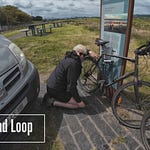Across the road from where I live is a large mobile home park, a stone’s throw from the beach in Tramore. As myself and Ellie passed it this morning, I was jokingly indignant at seeing a black and amber Kilkenny flag flying high in the sea breeze. “If they’re that proud of their county, let them set up camp in Ballyhale!” There’s a part of me that meant it.
On a fine summer’s day the Tipperary and Kilkenny reg cars flock to the Waterford coast. The slight inconvenience of not being able to park right outside my gate is often met by me muttering something under my breath about landlocked b@$t@rd$.
My curmudgeonly mumblings stem from supressed hurling championship disappointments that bubble up to the surface in ranty outbursts that decry bog-trotters with webbed feet coming down here taking all our best parking spaces.
I better keep that in check before I end up in the middle of the racecourse road roundabout waving a blue and white flag shouting “Tramore is full” at anyone who can’t tell a blaa from a bap.
The truth is that I’ve long drawn comfort from the fact that what Waterford might lack in All Ireland Senior Hurling Championship success, we make up for in picturesque beaches. Unfortunately we have now reached a point where if the devil himself was above at Kiely’s cross proffering a contract that outlined Waterford bringing the Liam McCarthy cup over the bridge after a win in Croke Park, I’d be willing to sign away the rights to Woodstown.
Myself and Ellie are conscious of our coastal bias when we head off for spins, but we’ve been working on it. When we wrote about some of our favourite cycle routes for The Irish Times last August, we were keen to include a couple of inland loops, and the one in the video above had us in Kilkenny for most of it.
This loop starts and finishes in Thomastown, taking in the postcard perfect villages of Inistioge, Graiguenamanagh and St. Mullins while following two rivers through three counties. It doesn’t have any waves or tides in it, but this is the kind of scenic route that would give an American tourist wet dreams.
When we finished this cycle we made it into a pub in Thomastown 15 minutes before the throw-in of the All Ireland Semi-Final between Clare and Kilkenny. I managed to keep my jingoism on the lowdown while on the wrong side of the border, but Ellie was a bit more vocal in her support of The Banner. We didn’t make any friends in that pub. We hope you enjoy this video half as much as we enjoyed that match.
If you would like to follow the route yourself, the directions are below. We’ve also included a snippet of the accompanying article we wrote.
If you use a map or route app and you’d like a .gpx map of the route we followed, let us know in the comments below and I can send it on to you.
Ellie writes:
A lot of our favourite cycles are in rugged wilderness, so this loop, mostly through gently rolling farmland with some woods, makes for variety. Inistioge and St Mullins are both great stopping off points and St Mullins is an amazing historical site that is definitely worth exploring.
The Gobán Saor, a mysterious travelling stonemason about whom many legends exist, is said to have built the original chapel where Saint Molaing settled and a statue pays tribute to the legend of the Mad Sweeney, an ancient king of the Dalriada who lost his mind in battle and wandered Ireland before meeting his demise in St Mullins.
8km along the Barrow Way between St Mullins and Graiguenamanagh sees you sharing an unpaved but level path with walkers and passing some phenomenally gorgeous lockhouses. The presence of cyclists on this stretch has stoked controversy in the past, with locals campaigning against the paving of this former tow path, so good manners, giving way to walkers and not zooming up behind them or hogging the path would be the classy approach.
At Graiguenamanagh there’s a swimming spot complete with lifeguards in summer, and plenty of riverbank for picnics.
Mark writes:
This is the prettiest of the five spins in this series. The towns along this route are what misty eyed emigrants conjure up when they dream of the auld sod. Inistioge is so photogenic that it has its own IMDB page.
It’s the spin along the old towpath from St. Mullins to Graiguenmanagh that floats my boat. This is not a cycle path; it’s a grass path that follows the old industrial towpath that was once well worn by horses pulling barges and narrowboats up and down this stretch of the Barrow. As it stands, walkers and cyclers coexist in a state of compromise on either side of this verdant and bumpy byway. Whether worn by legs or wheels, this gentrified version of the towpath has come a long way from its industrial beginnings of horse dung, coal slack, cut-throat river bandits, and rats. It’s beautiful now, but it was probably more exciting then.
The going gets muddy and slippery by bike once the ground gets wet, best avoided at the wettest times of year, but as a well-seasoned Cork woman told us in the woods above Glengarriff, “if we let a bit of rain stop us doing things in Ireland, we’d be f@€Ked.” Well said, madam.
Directions:
Park in Thomastown and take the R700 through Inistioge and over Garrett Bridge outside New Ross.
Turn left after the bridge and then left again onto the R729 signposted for St Mullins.
Take a left at St Brendan’s church. At St Mullins, turn right up the river bank, well signposted as part of the Barrow Way.
From Graiguenamanagh take the R703 back to Thomastown.
Hold her steady and keep it between the ditches!











Share this post